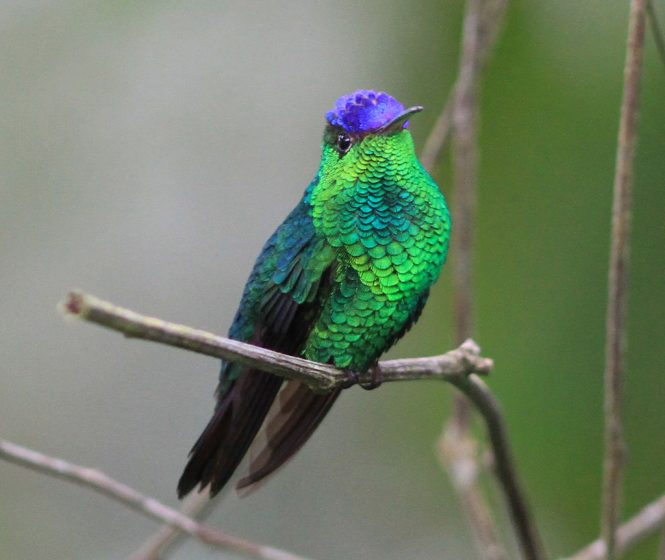Description: The violet-capped hummingbird (Goldmania violiceps) is rather similar to the Pirre Hummingbird in general appearance and closely related to that species. This species of hummingbird is in the family Trochilidae, mainly found in Panama and far northwestern Colombia.
Identification: This attractive hummingbird is bright, glistening green with (in the male) a deep violet cap that reaches just short of the nape. The wings and tail are bronzy purples with a glittering purple crown. The bill is black. The female is not flashy as compared to males, as it has green crown’s and grayish underparts and has some green spotting on the flanks and sides of the breast. Her pale tail is a little shorter than a male bird. Both the Violet-capped and Pirre Hummingbirds have unusually long, stiffened undertail feathers. This hummingbird usually forages alone, traplining a low-level route through the understory, where it takes nectar from shrubs such as Salvia and Palicourea. It will also visit hummingbird feeders.

Breeding: Its behavior is not yet well studied, but it is thought to be sedentary, neither live nor migrate with flocks, and it is known to breed between December and March. Even with no pair bonding, only males mate with several females for breeding purposes and abruptly separate from the female after copulation.
Eggs: The clutch contains one egg, which is normally pale white. The female incubates the egg. In this time, male bird protect the territory and provide flowers nectar to feed them. The chick is born blindly, and the female pushes the food intact with her long bill to the chick’s throats. The young bird brood in a week or two max and leaves the nest within 20 days.
Nest: The male bird does not participate in nest building. The big cup-shaped nest is made with plants; fiber is woven together, animal hairs feather down, and greenish moss around the nest for camouflage. The nest usually builds over the streams in a bush, shrub, or tree. The nest has enough elastic to accommodate the chick when more space is required. Moreover, these often visit other hummingbird feeders to take the sugar water, sip water, and perch on the edges.
Habitat: Tropical Moist lowland dense forest and forest edges; 1,950–3,950 feet (600–1,200 m). The forest habitat it occupies is mainly pristine, and it is a fairly common species in much of its restricted range. They have variable flight abilities to maneuver their wings almost 180° even still in space, hovering in front of flowers. The average speed is between 40 mph and 50 mph.
Feed: Violet-capped hummingbird mainly prefers small insects, spiders, high energy nectar of scented tiny flowers of shrub, herbs, trees, and epiphytes. Preferable banana flowers and heliconia, which are rich in sugar content. These birds are usually hanging with flowers and lick the nectar around 13 times per second. The native trees, or flowers, mainly rely on pollination. Small spiders and insects are often caught in flight, grabbed from branches, leaves and spider webs. A female or male bird captures more than 2,000 insects in a day.

Call song, sounds:
Violet-capped hummingbirds often make quick chip sounds. The colorful male bird has a high-pitched call “cheep tsew cheep tik-tik tsew.” These hummingbirds create sound with their wings, and you will listen to a different sound every time, depending on how fast they beat their wings. Every other species made a different humming sound in flight.
Status: The population is stable but slowly declines. Hence, it is observed at least concern. Perhaps an area or change in habitats is the main reason for the decline.
Distribution: The violet-capped hummingbird is found in central Panama, extending just into northwest Colombia.
Size: The average size is 33⁄8–33⁄4 in (8.5–9.5 cm) and the weight is about 3.5–4.5 g, just like a penny?







